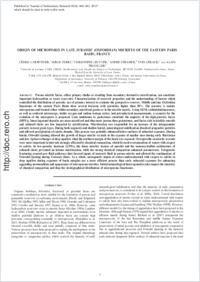Origin of micropores In late jurassic (Oxfordian) micrites of the eastern Paris basin, France
- Carpentier, Cédric Université de Lorraine, CNRS, CREGU, GeoRessources Lab, Faculté des Sciences et Technologies, Vandoeuvre-lès-Nancy, France
- Ferry, Serge Retired from the University of Lyon, France
- Lécuyer, Christophe Bâtiment Géode, Villeurbanne, France
- Strasser, André Department of Geosciences, University of Fribourg, Switzerland
- Géraud, Yves Université de Lorraine, CNRS, CREGU, GeoRessources Lab, Faculté des Sciences et Technologies, Vandoeuvre-lès-Nancy, France
- Trouiller, Alain ANDRA, Châtenay-Malabry, France
-
06.01.2015
Published in:
- Journal of Sedimentary Research. - 2015, vol. 85, no. 6, p. 660–682
English
Porous micritic facies, either primary chalks or resulting from secondary destructive micritization, can constitute important hydrocarbon or water reservoirs. Characterization of reservoir properties and the understanding of factors which controlled the distribution of porosity are of primary interest to evaluate the prospective reserves. Middle and late Oxfordian limestones of the eastern Paris Basin show several horizons with porosities higher than 20%. The porosity is mainly microporous and located either within secondary micritized grains or in the micritic matrix. Using SEM, cathodoluminescence, as well as confocal microscopy, stable oxygen and carbon isotope ratios, and petrophysical measurements, a scenario for the evolution of the micropores is proposed. Lime mudstones to packstones constitute the majority of the high-porosity facies (HPFs). Inner lagoonal deposits are more micritized and thus more porous than grainstones, and facies rich in leiolitic oncoids and echinoid clasts are less impacted by micritization. Micritization was responsible for an increase of the intragranular porosity in most grain types. During both eogenesis and shallow burial, mineralogical stabilization dissolved aragonitic particles and allowed precipitation of calcite rhombs. This process was probably enhanced below surfaces of subaerial exposure. During burial, Ostwald ripening allowed the growth of larger micrite crystals at the expense of smaller ones during early Berriasian and late Aptian recharges of deep aquifers when the northern margin of the basin was exposed. Overgrowths on micrite crystals were more important in intervals strongly affected by chemical compaction, which favored oversaturation of waters with respect to calcite. In low-porosity horizons (LPFs), the dense micritic texture of oncoids and the monocrystalline architecture of echinoid clasts prevented an intense micritization, while the strong chemical compaction enhanced poronecrosis. Telogenetic fracturing created new fluid pathways that favored inputs of meteoric fluid in porous micrite and allowed the continuation of Ostwald ripening during Cenozoic times. As a whole, mesogenetic inputs of waters undersaturated with respect to calcite in deep aquifers during exposure of basin margins are a more efficient process than early subaerial exposure for enhancing aggrading neomorphism and appearance of microporous micrites. Initial mineralogical heterogeneities also impact the intensity of chemical compaction and thus the stratigraphical distribution of microporous limestones.
- Faculty
- Faculté des sciences et de médecine
- Department
- Département de Géosciences
- Language
-
- English
- Classification
- Palaeontology
- License
-
License undefined
- Identifiers
-
- RERO DOC 257207
- DOI 10.2110/jsr.2015.37
- Persistent URL
- https://folia.unifr.ch/unifr/documents/304535
Statistics
Document views: 92
File downloads:
- pdf: 306
